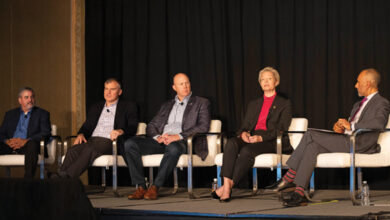Companies hope to take drilling with casing to subsea environment
Weatherford International and ENI have entered an agreement to develop a subsea drilling-with-casing system. It will enable a 20-in. casing string and its high-pressure wellhead housing to be drilled to a pre-determined depth, cemented in place and released in one run. The system will be capable of working with any high-pressure wellhead housing on the market.
The aim is to take the benefits of drilling with casing, like mitigating shallow hazards, to the previously non-applicable and costly subsea environment. In doing so, this system will minimize risk while allowing maximum flow area to be maintained. Ultimately, Weatherford believes that the system – called SeaLance – will allow the remaining casing seats to be pushed deeper into the wellbore. They also anticipate that the technology will further enable applications in subsalt plays.
Drillmec to supply 100th HH rig
Drillmec has signed the contract for its 100th HH rig, an automated hydraulic rig introduced to the land drilling market in 1996. The 100th HH will be supplied at the beginning of next year to ENEL, the national Italian electricity company. It will operate in the Larderello area of Tuscany for geothermal projects. The rig is a fully automatic HH-300.
Key features of the Drillmec design are: a trailer that can move on small and narrow roads; a substructure that can pass over the top of existing wellheads; and a vertical pipe storage and loading system that can accommodate a minimum of 3,500 m of 5-in. drill pipe.
RTCI system monitors sand screen deformations, casing shape
A Real-Time Compaction Imaging (RTCI) system has been unveiled that can lead to significant savings in well completions by using fiber optics to monitor sand screen deformations and casing shape in real time. The system, jointly developed by Shell and Baker Hughes Incorporated, was previewed on 9 July at the Baker Hughes Center for Technology Innovation in Houston.
The RTCI system uses Bragg grating sensors incorporated within a sand screen instrumented with optical fibers to monitor strain and acquire a three-dimensional high-resolution deformation image of the screen. Tens of thousands of the sensors are spaced helically as close as 1 cm apart, each capable of measuring sub-micrometer deformations. They provide continuous and real-time monitoring of well deformation, reservoir compaction and well integrity, all without intervention. They are also sensitive to all tubular strains, including axial, bending, crushing, pressure and temperature.
Vianney Koelman, Shell manager of in-well monitoring technology, noted that the operator decided to invest in this technology because there are many potential applications related to well integrity, production optimization and recovery optimization. One of the most important was measuring compaction and geomechanically induced well deformations, he said, which will provide early warnings for well failures – “an important reason we started all this back in 2002.”

 Bragg grating sensors, spaced as close as 1 cm apart, are incorporated within a sand screen instrumented with fiber optics and used in Shell and Baker Hughes’ Real-Time Compaction Imaging system. It can acquire a 3D high-resolution deformation image of the screen, providing continuous monitoring in real time.
Bragg grating sensors, spaced as close as 1 cm apart, are incorporated within a sand screen instrumented with fiber optics and used in Shell and Baker Hughes’ Real-Time Compaction Imaging system. It can acquire a 3D high-resolution deformation image of the screen, providing continuous monitoring in real time.
“This is not a technology that is just an improvement over an existing technology. This is providing completely new measurements (that we weren’t capable of measuring before)… it will open up a whole new playground that will lead to further understanding what is going on downhole.”
Current deployment options for the RTCI are casing and 9 5/8-in. gravel pack systems. The first successful trial of the RTCI on casing took place at Shell’s Pinedale, Wyo., operations in 2008. The system was applied on two joints of 7-in. casing at different wrap angles – the wrap angle dictates sensitivity to a particular deformation mode. Key events during casing cementing (pumping cement, bumping the plug and cure) were clearly visible in the data.
A successful test of a sand control completion integrated with the fiber-optic RTCI system was completed in January 2009 at the Baker Hughes BETA test rig in Oklahoma. During the test, the wet connect successfully mated eight fibers with excellent optical connectivity (approximately 0.5 dB loss).
Additional field testing is planned for Q4 this year, when the system is expected to become available on the market.
To see a video of the RTCI horizontal gravel pack strain test, conducted in May 2009, click here.
Drill bit SWD system promises to truly ‘see’ ahead of the bit
Technology International has developed a borehole imaging system based on drill bit seismic-while-drilling (SWD) technologies that use a downhole acoustic source and receivers at the surface to create real-time images. The result, they say, is that operators will be able to “see” ahead of the drill bit.
According to the US Department of Energy (DOE), which sponsored the project, all possible borehole pulsed sources produce high frequencies by their nature. This is counter to the need for low frequencies that transmit long distances through rock. The new tool has a unique sparker control system that can be adjusted from the surface to meet the demands of depth, rock properties and other geological variances.
Built into or attached onto the drillstring, the system emits broadband low-frequency sounds that, based on seismic calculations, can be transmitted to surface receivers from depths beyond 30,000 ft. It will provide accurate drill bit location relative to pre-drill reservoir models and real-time images roughly 1,000 ft ahead of the drill bit – without interfering with normal drilling operations, according to project managers.
They add that the system can improve safety and reduce costs by detecting unexpected pore pressures ahead of the bit. It also will allow operators to visualize and steer toward more optimal targets when drilling deep formations.
Called the SeismicPULSER, the new system was developed for harsh high-pressure, high-temperature environments found in deep onshore and offshore deepwater wells. It is nearing commercialization. Field testing has been performed at the University of Texas’ Devine seismic test site and the DOE’s Rocky Mountain Oilfield Testing Center near Casper, Wyo.
Click here for a Q&A with Technology International president Robert Radtke on the development of this technology, from the July/August 2008 issue of DC.
Hughes Christensen two-cone bit designated as historical landmark
![]() The two-cone bit replaced the traditional fishtail bit in the early 1900s.
The two-cone bit replaced the traditional fishtail bit in the early 1900s.
The American Society of Mechanical Engineers (ASME) has designated the Hughes Christensen two-cone drill bit as a Historic Mechanical Engineering Landmark.
The designation was presented during a ceremony at the Baker Hughes drill bit technology facility in The Woodlands, Texas, on 10 August – the 100th anniversary of the two-cone drill bit patent.
An early production two-cone drill bit will be permanently displayed in the lobby at this facility.
“The Hughes two-cone drill bit launched Hughes Tool Company. Perhaps more important, many experts view it as a key technology that ushered in a new era of abundant, inexpensive fuel,” said Scott Schmidt, president of the Hughes Christensen product line.
Prior to 1909, the traditional fishtail bit scraped the rock and quickly dulled in service. The two-cone bit’s rolling action crushed hard-rock formations, allowing drillers to tap vast oil reservoirs deep below the surface.
The ASME History and Heritage Landmarks Program began in 1971 and has designated nearly 250 landmarks as historic mechanical engineering landmarks, heritage collections or heritage sites. Each represents a progressive step in the evolution of mechanical engineering and its significance to society.
Longest horizontal well built in Abu Dhabi field
An operator in Abu Dhabi has successfully drilled, logged and completed the longest horizontal well in the ASAB Field in Abu Dhabi. After the 7-in. shoe was landed at 9,250 ft (2,820 m), the 6-in. hole was drilled to 14,343 ft (4067 m), the well was logged, then an open-hole isolation completion was installed.
Baker Hughes deployed the INTEQ 4 ¾-in. StarTrak LWD and reservoir navigation tools along with AutoTrak/LithoTrak systems to drill the well. A Hughes Christensen bit was used, achieving an average ROP of 50.5 ft/hr (15.4 m/hr). The well completed with the installation of five Baker Oil Tools REPackers to compartmentalize 5,000 ft (1,524 m) of 6-in. open-hole section of the well.
Separately, an European operator has drilled the longest casing-while-drilling run in the Eastern Hemisphere using the Hughes Christensen EZCase bit. It was run on an onshore exploration well drilled with a new rig. The objectives were to drill and case-off the loose tertiary sand and reactive shale and to use the run to gradually introduce the drilling crew to an unfamiliar automated rig system.
The bit drilled from surface to 780 m (2,559 ft) MD in 71 hours with an on-bottom ROP of 11 m/hr (36 ft/hr) using controlled drilling. The casing was successfully cemented through the EZCase shoe, and the bit was drilled out in 1.5 hours with a Genesis 8 ½-in. “drill-out” PDC bit. The bit went on to drill to section TD at 2,075 m (6,808 ft).



